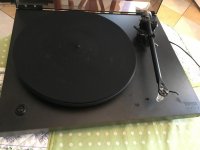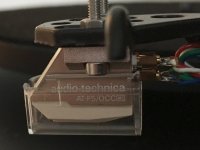I just came across this: LME49720
There is an RIAA design on the first page. Polypropylene capacitors, no electrolytics, passive, better amp.
How are you intending to power the P05 psu...by its own transformer or a SMPS? I have some suggestions for this PSU but it depends how fussy you are.
There is an RIAA design on the first page. Polypropylene capacitors, no electrolytics, passive, better amp.
How are you intending to power the P05 psu...by its own transformer or a SMPS? I have some suggestions for this PSU but it depends how fussy you are.
Last edited:
I just came across this: LME49720
There is an RIAA design on the first page. Polypropylene capacitors, no electrolytics, passive, better amp.
How are you intending to power the P05 psu...by its own transformer or a SMPS? I have some suggestions for this PSU but it depends how fussy you are.
Interesting, I was going to say nice simple circuit, but 3320R, could only possibly get that value in a SMD Resistor, and 22nf/4.7nf//500pf .... Couldn't they make their minds up 🙂
The Rod Elliot PSU is being driven from a separate mains transformer in its own shielded case, and connected by means of a 4 pin plug and cable, the 4th core of the cable can be used as a chassis mains earth.
I think 3300 would be fine because it only sets the opamp gain rather than the filter frequencies. But you could combine a 3.3k and a 20 in series. I think with the capacitors it means to combine three caps in parallel so they add together.
Getting the RIAA poles and zeros right requires some component accuracy whichever design you choose.
Getting the RIAA poles and zeros right requires some component accuracy whichever design you choose.
3320ohms could be a 3k3 +-1% or a 3k3 +-0.1%Interesting, I was going to say nice simple circuit, but 3320R, could only possibly get that value in a SMD Resistor, and 22nf/4.7nf//500pf .... Couldn't they make their minds up 🙂
The Rod Elliot PSU is being driven from a separate mains transformer in its own shielded case, and connected by means of a 4 pin plug and cable, the 4th core of the cable can be used as a chassis mains earth.
Then trim it with a low value series resistor to bring it to the required value, if you can measure that accurately.
Well this thread is motivating me to get my Rega Planar 3 out of mothballs. I also need a phono amp so I'm going to build this TI one on a breadboard. I'll power it from 9V batteries and see how it does.
From the TI datasheet I require a 7.4nF and an 80nF at 5% tolerance which the datasheet has made by paralleling standard cap values.
Because I already have some 10nF caps I am going to use these combinations to minimize the number of caps I need to buy:
10nF in series with 27nF = 7.30nF
10nF || 68nF = 78nF
I have a capacitance meter so I can try combinations to get close to the ideal.
Instead of 26.1k + 909 I'll buy 27.0k resistors.
Instead of 3.83k + 100 I'll buy 3.92k.
From the TI datasheet I require a 7.4nF and an 80nF at 5% tolerance which the datasheet has made by paralleling standard cap values.
Because I already have some 10nF caps I am going to use these combinations to minimize the number of caps I need to buy:
10nF in series with 27nF = 7.30nF
10nF || 68nF = 78nF
I have a capacitance meter so I can try combinations to get close to the ideal.
Instead of 26.1k + 909 I'll buy 27.0k resistors.
Instead of 3.83k + 100 I'll buy 3.92k.
Well this thread is motivating me to get my Rega Planar 3 out of mothballs. I also need a phono amp so I'm going to build this TI one on a breadboard. I'll power it from 9V batteries and see how it does.
Haha, That's the spirit, especially if you have a large vinyl collection, something very tactile about vinyl 🙂
A word of warning about the rega, If the anti skate is set as you used to have it and you don't need to adjust it, then don't move it, chances are the belt will break, and you will end up in the same situation as me, it's a well known problem with the R200 arm, and I only found out after it was too late.
The TI RIAA project looks interesting, please keep us posted as to how you get on, and how it performs.
The capacitor values were a little confusing, I didn't consider the paralleled option, I thought it was a and / or configuration depending on what was required.
3320ohms could be a 3k3 +-1% or a 3k3 +-0.1%
Then trim it with a low value series resistor to bring it to the required value, if you can measure that accurately.
Hi Andrew, I think 3.3k @ 1% would be fine, especially if the tolerance is near the top end giving a +/- 33R margin, If you had say 20 of them, I don't think it would be hard to find two that were very near the mark.
I spent ages matching the resistors and capacitors for my own RIAA board, and it's surprising how much variation there is, and in a lot of cases the values were not exact, but more of a choice of two resistors or capacitors that had the same value.
Oops. I don't know where my head was when I wrote post #327.
The compound capacitor values that TI use are 80nF and 27.2nF. Not 7.4nF!!!
I found this site for calculating the exact values: mh-audio.nl - Phono
When I put TI's series resistor value of 27.0k I get the other resistor 3926 ohms and the caps 81.0nF and 27.8nF. That's better. 🙂
The compound capacitor values that TI use are 80nF and 27.2nF. Not 7.4nF!!!
I found this site for calculating the exact values: mh-audio.nl - Phono
When I put TI's series resistor value of 27.0k I get the other resistor 3926 ohms and the caps 81.0nF and 27.8nF. That's better. 🙂
From the TI datasheet I require a 7.4nF and an 80nF at 5% tolerance which the datasheet has made by paralleling standard cap values.
Because I already have some 10nF caps I am going to use these combinations to minimize the number of caps I need to buy.
I can see the 80nf, but where did the 7.4nf come from? am I looking at the same circuit?
Oops. I don't know where my head was when I wrote post #327.
The compound capacitor values that TI use are 80nF and 27.2nF. Not 7.4nF!!!
I found this site for calculating the exact values: mh-audio.nl - Phono
When I put TI's series resistor value of 27.0k I get the other resistor 3926 ohms and the caps 81.0nF and 27.8nF. That's better. 🙂
Thats better 🙂
Is this your Rod Elliot board or a different one? Just wondering how far you've got with your phono amp/tone control build.I spent ages matching the resistors and capacitors for my own RIAA board, and it's surprising how much variation there is, and in a lot of cases the values were not exact, but more of a choice of two resistors or capacitors that had the same value.
Is this your Rod Elliot board or a different one? Just wondering how far you've got with your phono amp/tone control build.
Yes, this is the Rod Elliot PSU, RIAA and Tone control.
I have the boards built, minus the OPA2134 IC's, they will go in last due to ESD reasons, so I'm doing the signal wiring and switching at the moment, the supply wiring is done, and I'm also waiting for the enclosure for the mains transformer to arrive, shouldn't be long now before I can fire everything up.
I built Elliott RIAA P06 stage and it works excellent. There is no need to chase precision parts for the TI passive circuit. ESP RIAA is within 0,5dB from the RIAA curve. That is good enough for even the ambitious vinyl enthusiast. The only thing that you can do is to put input cap across RIAA input. Suitable value is 100-220pF. Without it you can have better RIAA curve conformity but you are risking to get too dull sound. Most MM cartridges are built in such a way that they require additional capacity at the input to help HF response. Caps could be located directly across RCA input connectors.
Here it is! It must have been in the loft for 20+ years. A little oil spilt but looks fine. I'll give it a clean. Needs a drop of sewing machine oil. It has an Audio Technica moving coil cartridge.
Attachments
Last edited:
Here it is! It must have been in the loft for 20+ years. A little oil spilt but looks fine. I'll give it a clean. Needs a drop of sewing machine oil. It has an Audio Technica moving coil cartridge.
Nice, I notice it doesn't have the R200 arm, so you probably wont have any issues with the Anti Skate.
Being a MC, will you still need a transformer before the phono stage, or don't they use them these days? I'm so out of the loop 🙂
I built Elliott RIAA P06 stage and it works excellent. There is no need to chase precision parts for the TI passive circuit. ESP RIAA is within 0,5dB from the RIAA curve. That is good enough for even the ambitious vinyl enthusiast. The only thing that you can do is to put input cap across RIAA input. Suitable value is 100-220pF. Without it you can have better RIAA curve conformity but you are risking to get too dull sound. Most MM cartridges are built in such a way that they require additional capacity at the input to help HF response. Caps could be located directly across RCA input connectors.
I'll be using the Ortofon VMS20E MKII cartridge, it always had a very smooth sound to me, It's going to be some time before I can get to use the phono stage properly, first I have to repair the anti skate belt on the Rega, if I don't wreck the arm in the process, and then I need to find a suitable surface to place it, which will probably be wall mounted as we have wooden floors.
Record players are SO nostalgic! I don't have one anymore but every time I see pictures like that I want one again....................or do I.......mmmmmHere it is! It must have been in the loft for 20+ years. A little oil spilt but looks fine. I'll give it a clean. Needs a drop of sewing machine oil. It has an Audio Technica moving coil cartridge.
Record players are SO nostalgic! I don't have one anymore but every time I see pictures like that I want one again....................or do I.......mmmmm
Of course you do..... especially if you still have a record collection, It wasn't until I was going though my own collection I realised how many great albums there were and how many tracks I hadn't heard or even thought about for years, great to see the price tags on them as well, WHS £4.95 🙂
It was that, that really got this whole thing started.
I have a couple of Ortofon T-5s but I’m thinking about avoiding them by boosting the opamp gains. However, I need to figure out what Z to load the cartridge with...Being a MC, will you still need a transformer before the phono stage, or don't they use them these days? I'm so out of the loop 🙂
- Home
- Amplifiers
- Solid State
- Any Maplin MosFet Amp Guru's on here?

